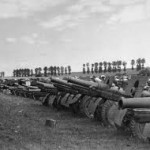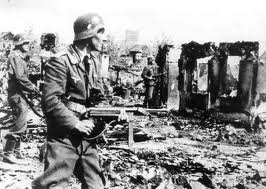Molotov Ribbentrop Pact
After the initial invasion and division of Poland, Germany and the Soviet Union respected the terms of their non-aggression pact (Molotov Ribbentrop pact ). Each side received half of Poland and the assurance that there would be no further aggression. This pact brought a great deal of hatred towards Russia from the western powers.
Concerns
Leader of the Soviet Union Joseph Stalin was initially very worried about Hitler.
He had read Hitler’s book Mein Kamph. It was clear that Hitler was extremely anti-communist based on how he came to power. His book was anti-Slavic and anti-Semetic. It was clear that Hitler wanted to eliminate all the peoples of Eastern Europe in order to open the way for German colonization. Stalin and understood that Hitler had clear intentions of turning everything East of Germany into a colony, however, once the pact was signed Stalin was lulled into a false sense of security.
Rebuilding from the Purges
He believed that he had plenty of time to rebuild and retrain his military forces before Germany was finished with the western powers and would see the Soviet Union as its next threat.
Stalin had purged most senior officers in the Russian military during the 1930’s because he believed that they were a threat to his power. So the armed forces of Russia were lacking in leadership and experience in the early 1940’s.
OPERATION SEALION
- Operation SEALION was the planned land invasion of Britain by Germany. It was scheduled for early 1941 but was called off indefinitely due to the failure of the German Luftwaffe to gain air superiority over Britain during the Battle of Britain. When the operation was called off Hitler decided to move a great deal of his forces into Poland and prepare for the invasion of Russia.
- Stalin noticed this buildup and directly questioned Hitler about his intentions.
- In response Hitler lied to him and stated that this buildup was designed to mislead Britain.
- Hitler told Stalin that he was making it look like he had given up on Britain in order to attack the Soviet Union, then he would swing his forces around and attack Britain when they were least expecting invasion. Stalin believed this lie completely and took Hitler at his word.
Richard Sorge
During the 1930’s the Soviet Union had placed one of its intelligence operatives Richard Sorge in Japan to collect information on Japanese Imperialist developments and to collect information on Japanese contact with Germany. Sorge able to create an efficient intelligence network in Japan and even managed to make personal contacts with officials at the German embassy in Tokyo. Through these contacts Sorge was able to almost completely uncover the plans for OPERATION BARBAROSSA. When he relayed this information to Stalin, Stalin accused him of stirring up trouble. Stalin preferred to rely on his own interpretation of events rather than the warnings of an intelligence officer in a far off country. Once the invasion had begun on June 22nd 1941 Sorge was able to relay information that stated Germany’s ally Japan would not invade the Soviet Union from the East. This allowed massive reinforcements to be moved from Siberia to defend the front. In the end Sorge was caught by Japanese officials and executed for espionage.
OPERATION BARBAROSSA
- In the early morning of June 22nd 1941 German forces attacked Russian forces through Poland and began their push East.
 Initially Stalin did not believe the reports coming in that the Germans had invaded, he believed it was an elaborate ruse created by the British to draw the Soviets into the war. He was so upset that he locked himself in his room for days.
Initially Stalin did not believe the reports coming in that the Germans had invaded, he believed it was an elaborate ruse created by the British to draw the Soviets into the war. He was so upset that he locked himself in his room for days. - 3million German troops and over 3000 tanks were used in the initial assault.
- German troops were better trained and their military equipment was more efficient than the Russians. Many Russians were not armed as there were not enough supplies for the entire Russian Army.
- After the fall of Minsk on June 30th Stalin made it clear that failure and retreat would be met with death by executing the Soviet Commanders of the city. All major tactical decisions would go through Stalin. The Russians saw this operation as a separate war from the previous conflicts hence. This war was to defend the Russian homeland so they called it “The Great Patriotic War”
- The Russians reverted to a traditional military tactic called “Scorched Earth”
Scorched Earth
Scorched Earth is a tactic that has been used effectively for hundreds of years. The Russians used it against Napoleon in the early 1800’s. When retreating from an area all industrial capacity and supplies should be removed or destroyed. All civilians should be uprooted and move with the army to prevent military leaks and slave labour. In many cases cities and farms would literally be burned to the ground to leave no infrastructure behind. This creates very long supply lines for the advancing army. In Russia a lack of supplies in a harsh winter can mean defeat and death.
The Halt of the Blitzkrieg
- By November 1941 German forces had pushed their way to the exterior of Moscow and were held back by Soviet Forces.
- The secondary capital Leningrad had also been placed under siege and would not see movement until 1944.
- By the summer of 1942 the Battle of Stalingrad had started in the south of Russia. A German force of 250 000 men 500 tanks and 700 guns were held at Stalingrad. Their biggest problem was the fact that the Germans had started running out of fuel. They can not continue the war without the Oil fields in south Russia.
- By October of 1941 the Germans were running out of the key supplies Oil, Rubber, Grain and Manganese (steel production) all of which were resources that were heavily imported from the Soviet Union before BARBAROSSA.
Stalingrad
- Fighting in the city went street to street, building to building in true guerrilla warfare.

- Soviet troops and citizens of Stalingrad were being shot for fleeing.
- Many were malnourished, most soldiers lacked a weapon.
- By late September 1942 the Germans had captured the main political buildings of Stalingrad but the fighting was still continuing throughout the city.
- Both sides were experiencing horrendous casualties. The Germans had suffered over 40 000 and the Soviets were approaching 100 000. The Germans were running out of men, the Soviets had many more reinforcements on the way from Siberia.
- By January 1943 the Germans were facing a harsh winter, low supplies, lack of fuel, high numbers of wounded and a shortage of men. On the 31st the Germans formally surrendered.
- Over 91 000 Germans were captured and 150 000 had died in the fight. 45 000 more died on the march to POW camps and only 7000 survived the war.
- This is one of the three key turning points of WWII in 1943 (the others being Midway and El-Aleman)
- After this battle the Germans would not see the victories and advances that they achieved in the first few years of the war.
